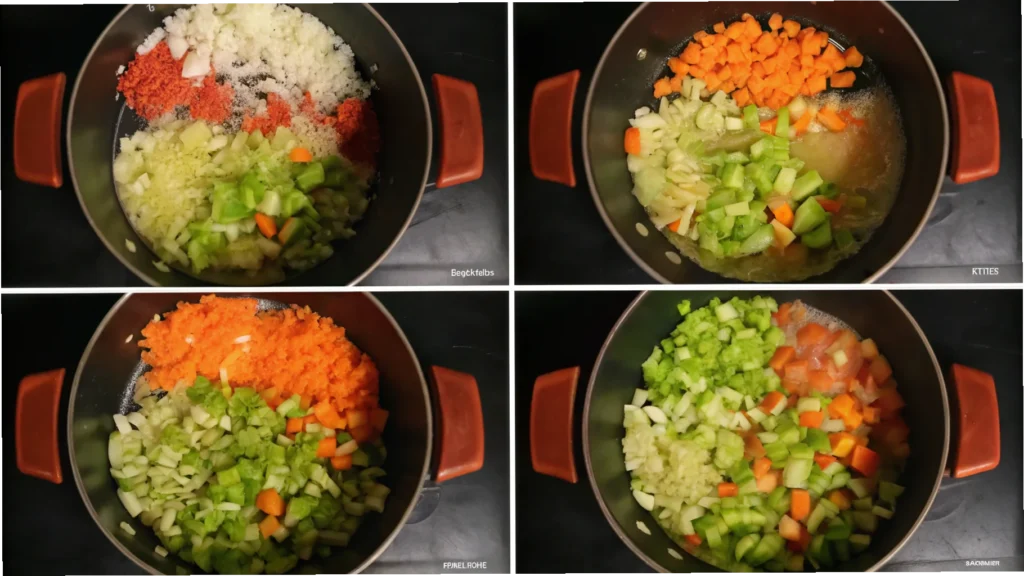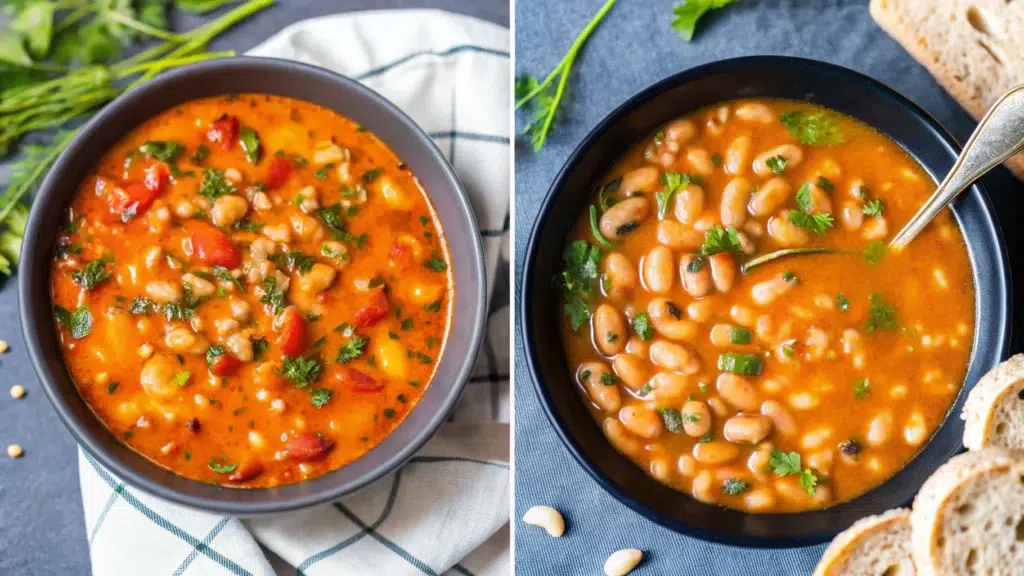Black-eyed pea soup is a shining example of wholesome, flavorful cooking rooted in tradition. Bursting with nutrition, endlessly customizable, and steeped in cultural heritage, it’s a dish worthy of a spot in your kitchen repertoire. Whether you’re craving a comforting bowl of warmth or embracing the tradition of a New Year’s good luck meal, this guide has you covered. From its fascinating history and notable health benefits to practical preparation tips, you’ll find everything you need to create a soup that nourishes both body and spirit.
Introduction to Black-Eyed Pea Soup
The Historical and Cultural Significance of Black-Eyed Peas
Black-eyed peas aren’t just an ingredient; they’re a tradition. These small legumes, with their distinctive black spot, have been a staple in Southern kitchens for centuries. Thought to bring good fortune and prosperity, they’ve become a symbol of hope during New Year’s celebrations. This belief traces back to the Civil War era when the humble black-eyed pea saved many families from hunger. Over time, they’ve earned their spot as a must-have in festive dishes, particularly when paired with greens (symbolizing money) and cornbread (signifying gold).
Why Black-Eyed Pea Soup Deserves a Spot in Your Meal Plan
What makes black-eyed pea soup such a beloved dish? It’s versatile, nutritious, and incredibly satisfying. Packed with fiber, potassium, and iron, these legumes offer incredible nutritional benefits. When paired with fresh greens, a source of protein, and a savory broth, they create a satisfying soup that’s both simple to make and ideal for any occasion. The recipe is highly versatile, allowing you to tailor it to your taste—whether you prefer a vegan, vegetarian, or meat-focused version.Whether you’re whipping up a quick weeknight dinner or simmering something special for Sunday, black-eyed pea soup has got your back.
- Introduction to Black-Eyed Pea Soup
- Ingredients Breakdown
- Step-by-Step Preparation
- Flavor Variations and Customizations
- Serving Suggestions
- Storage and Make-Ahead Tips
- FAQs About Black-Eyed Pea Soup
- LLSI and NLP Keywords for Black-Eyed Pea Soup
- Wrapping Up and Additional Resources
- Wrapping Up and Additional Resources
Ingredients Breakdown

Step-by-Step Preparation
Preparing Your Ingredients
The first step to a successful black-eyed pea soup is gathering and prepping ingredients. Start by chopping onions, celery, carrots, and red bell peppers. These aromatics form the base of your soup and will enhance its flavor. Mince fresh garlic for a robust kick, and measure out your spices, including Cajun seasoning, thyme, and crushed red pepper flakes.
If you’re using fresh greens, wash them thoroughly and chop them into bite-sized pieces. For the protein, dice ham, sausage, or your chosen alternative. If you’re using canned black-eyed peas, rinse them under cold water to remove the briny taste.
Cooking Methods: Stovetop, Slow Cooker, or Instant Pot
You can prepare black-eyed pea soup in various ways, depending on your available time and tools.
On the Stovetop: Heat olive oil in a large pot or Dutch oven over medium-high heat. Sauté the aromatics until they’re soft, then add garlic and spices. Stir briefly to release their aromas. Next, add your broth, diced tomatoes, and protein, bringing everything to a gentle simmer. Finally, toss in the greens and black-eyed peas, cooking until the greens wilt.
In a Slow Cooker:If you’re looking for an easy, hands-off method, simply add all the ingredients except the greens into a slow cooker. Cook on low for 6–8 hours or on high for 3–4 hours. For vibrant color and optimal texture, stir in the greens during the final 20–30 minutes of cooking.
Using an Instant Pot: For a quick and easy option, sauté the aromatics directly in the Instant Pot using the sauté function. Add the remaining ingredients, seal the lid, and pressure cook on high for 8-10 minutes. After releasing the pressure, stir in the greens and allow them to soften.
Tips for Perfectly Balanced Flavors
Achieving the perfect balance of flavors in your black-eyed pea soup is easier than you might think. Use smoked proteins like ham hocks or turkey legs for depth, and don’t shy away from spices. They’re the heart of this dish’s flavor.
To add a refreshing burst of brightness, drizzle a bit of fresh lemon juice over the soup just before serving. Don’t forget to taste as you cook, adjusting the seasoning with salt and black pepper to perfectly match your preferences. With these simple touches, your soup will turn out flavorful and satisfying every time.
Flavor Variations and Customizations
Vegan and Vegetarian-Friendly Adjustments
Making black-eyed pea soup vegan or vegetarian is simple and delicious. Instead of ham or sausage, use plant-based proteins like vegan sausage or smoked tofu to replicate the smoky depth of flavor. Mushrooms, particularly shiitake or portobello, are excellent substitutes for their meaty texture. Swap chicken broth for vegetable broth to keep the soup rich and hearty without compromising its plant-based appeal.
Additionally, adding more vegetables like sweet potatoes, zucchini, or even bell peppers can enhance the soup’s nutritional value and variety. With these adjustments, the soup becomes a satisfying, meat-free meal that everyone can enjoy.
Adding Protein: Ham, Sausage, or Plant-Based Alternatives
If you prefer a heartier version of black-eyed pea soup, adding proteins like ham, smoked sausage, or turkey is a popular choice. Smoked turkey legs or ham hocks infuse the broth with a deep, savory flavor, making the soup even more comforting. For a spicy kick, consider using Andouille sausage.
For plant-based diets, options like tempeh or seitan can mimic the chewiness of meat. Smoked paprika or liquid smoke can further enhance the flavor, giving the soup a depth that rivals traditional recipes. Regardless of your protein choice, the soup remains a crowd-pleaser.
Regional Twists: Southern, Cajun, and More
Regional variations add a unique spin to black-eyed pea soup. Southern-style versions often include collard greens and cornbread on the side, staying true to tradition. Cajun-inspired recipes add bold spices like cayenne pepper, paprika, and thyme for a robust, spicy flavor.
In Mediterranean adaptations, fresh herbs like parsley and oregano, along with a drizzle of olive oil, bring a light and zesty twist. Whether you stick to tradition or try a new regional flavor, the versatility of black-eyed pea soup makes it endlessly adaptable.
For more comforting soup recipes, check out this Old-Fashioned Vegetable Beef Soup on Larder Recipes.
Serving Suggestions
Best Sides to Complement Black-Eyed Pea Soup
Serving black-eyed pea soup with the right sides elevates the meal to new heights. Cornbread is a classic choice, with its slightly sweet flavor perfectly balancing the savory soup. Other great options include garlic bread, buttery biscuits, or even crusty artisan bread for dipping.
For a lighter side, a fresh green salad with a tangy vinaigrette provides a crisp contrast to the hearty soup. If you’re feeling indulgent, consider pairing the soup with creamy mashed potatoes or a side of cheesy grits for a Southern-inspired feast.
Pairing Drinks and Desserts for a Full Meal
To round out the meal, choose a drink that highlights the flavors of your black-eyed pea soup. Sweet iced tea offers a classic Southern pairing, while a crisp white wine like Sauvignon Blanc beautifully balances the soup’s richness. For a refreshing, non-alcoholic option, try sparkling water with a hint of citrus for a light, zesty touch.
Finish the meal with a simple dessert like peach cobbler or a slice of lemon pound cake. These treats offer a touch of sweetness that balances the bold, savory flavors of the soup. Together, these pairings create a satisfying and memorable dining experience.
Storage and Make-Ahead Tips
How to Store Leftovers Safely
Storing your leftover black-eyed pea soup properly is key to preserving its flavor and freshness. Begin by allowing the soup to cool to room temperature. Then, transfer it to airtight containers and store it in the refrigerator. When stored this way, the soup can last for up to five days. To reheat, simply warm it on the stovetop over low heat, stirring occasionally, or microwave it in a microwave-safe dish.
If you’re storing the soup with greens, keep in mind that their color may deepen over time, but this won’t affect the taste. For a fresh touch, consider adding more greens when reheating.
Freezing and Reheating Tips for Busy Days
For longer storage, black-eyed pea soup freezes exceptionally well. Divide the soup into portion-sized containers or freezer bags, leaving a bit of space for expansion. Freeze the containers flat if using bags for easier storage. Frozen soup can last up to three months without losing its delicious taste.
When it’s time to enjoy the soup again, Throw it in the refrigerator overnight for a slow and safe method, or use the defrost setting on your microwave for quicker results when you’re short on time. Reheat on the stovetop, and if the soup seems thick, add a splash of water or broth to restore its consistency. This makes enjoying a warm, homemade meal on a busy day incredibly simple.
FAQs About Black-Eyed Pea Soup
Why Are Black-Eyed Peas Considered Lucky?
Black-eyed peas are often associated with good luck and prosperity, particularly in Southern traditions. This belief stems from the Civil War era when they became a crucial food source for many families. Paired with greens, symbolizing money, and cornbread, representing gold, they form a trio thought to bring wealth and fortune for the year ahead.
While black-eyed pea soup holds symbolic meaning, its popularity extends far beyond New Year’s celebrations. It’s a nutritious, flavorful dish that’s perfect for any day of the year.
Can I Make This Soup Without Greens?
Absolutely! While greens like collards, kale, or Swiss chard add flavor and nutrients, the soup is still delicious without them. To maintain a balance of textures, consider adding diced carrots, zucchini, or sweet potatoes. If you skip the greens but still want a traditional Southern touch, serve the soup alongside cornbread or biscuits for added richness.
What Are the Best Substitutes for Chicken Broth?
If you don’t have chicken broth on hand or prefer a vegetarian option, there are several substitutes to consider. Vegetable broth is an easy swap that works seamlessly with the soup’s flavors. Alternatively, use water mixed with a bouillon cube for a cost-effective option. For a richer taste, try mushroom broth, which adds an earthy depth to black-eyed pea soup.

LLSI and NLP Keywords for Black-Eyed Pea Soup
Enhancing Searchability with Related Keywords
To make your black-eyed pea soup recipe more discoverable and appealing to readers, it’s essential to naturally incorporate related keywords and phrases. These terms improve search engine optimization (SEO) and provide variety and depth to your content.
Some effective keywords include:
- Southern black-eyed pea soup recipe
- Vegetarian black-eyed pea soup
- Traditional New Year’s soup
- Healthy legume soup ideas
- Easy black-eyed pea recipes
- Collard greens and black-eyed peas
- Protein-packed soups with legumes
By weaving these terms into your article, you can reach a wider audience that is searching for variations or specific aspects of the dish.
Creating Richer Content with Semantic Keywords
In addition to specific phrases, semantic keywords help contextualize your black-eyed pea soup article. Words and phrases like “fiber-rich soups,” “comfort food,” “hearty meals,” and “low-calorie soups” resonate with readers looking for health-focused or satisfying meal options.
Using these keywords strategically not only improves your article’s relevance but also ensures it caters to your audience’s diverse needs, whether they’re seeking a quick weeknight meal or a traditional recipe.
Wrapping Up and Additional Resources
Making Black-Eyed Pea Soup a Regular Favorite
Black-eyed pea soup isn’t just a dish for New Year’s; it’s a meal that can fit into your routine any time of the year. Its wholesome ingredients, hearty flavors, and cultural significance make it a staple worth adding to your recipe collection. Whether you prefer the classic Southern style or a customized vegan version, this soup offers something for everyone.
Pair it with cornbread, a crisp salad, or even your favorite dessert for a complete and satisfying meal. Black-eyed pea soup remains a versatile and timeless dish with so many variations and preparation options.SI and NLP Keywords for Black-Eyed Pea Soup
Enhancing Searchability with Related Keywords
To make your black-eyed pea soup recipe more discoverable and appealing to readers, it’s essential to incorporate related keywords and phrases naturally. These terms not only improve search engine optimization (SEO) but also provide variety and depth to your content.
Some effective keywords include:
- Southern black-eyed pea soup recipe
- Vegetarian black-eyed pea soup
- Traditional New Year’s soup
- Healthy legume soup ideas
- Easy black-eyed pea recipes
- Collard greens and black-eyed peas
- Protein-packed soups with legumes
By weaving these terms into your article, you can capture a wider audience searching for variations or specific aspects of the dish.
Creating Richer Content with Semantic Keywords
In addition to specific phrases, semantic keywords help contextualize your black-eyed pea soup article. Words and phrases like “fiber-rich soups,” “comfort food,” “hearty meals,” and “low-calorie soups” resonate with readers looking for health-focused or satisfying meal options.
Using these keywords strategically not only improves your article’s relevance but also ensures it caters to the diverse needs of your audience, whether they’re seeking a quick weeknight meal or a traditional recipe.
Wrapping Up and Additional Resources
Making Black-Eyed Pea Soup a Regular Favorite
Black-eyed pea soup isn’t just a dish for New Year’s it’s a meal that can fit into your routine any time of the year. Its wholesome ingredients, hearty flavors, and cultural significance make it a staple worth adding to your recipe collection. Whether you prefer the classic Southern style or a customized vegan version, this soup offers something for everyone.
Pair it with cornbread, a crisp salad, or even your favorite dessert for a complete and satisfying meal. With so many variations and preparation options, black-eyed pea soup remains a versatile and timeless dish.
Explore More Recipes
If you’ve enjoyed learning about this hearty soup, there’s plenty more to explore. For another comforting and traditional option, check out this Old-Fashioned Vegetable Beef Soup Recipe on Larder Recipes. It’s the perfect companion to your collection of warming, satisfying dishes.
Print
black eyed pea soup
- Prep Time: 15 minutes
- Cook Time: 30 minutes
- Total Time: 45 minutes
Ingredients
- 2 tablespoons olive oil
- 1 large onion, chopped
- 2 stalks celery, chopped
- 1 large carrot, diced
- 1 small red bell pepper, diced
- 5 cloves garlic, minced
- 1 tablespoon Cajun seasoning
- 1 teaspoon dried thyme
- 1/4 teaspoon crushed red pepper flakes (adjust to taste)
- 6 cups chicken or vegetable broth
- 1 can (15 ounces) fire-roasted tomatoes, undrained
- 8 ounces diced ham (or smoked sausage, turkey, or plant-based alternatives)
- 6–8 cups chopped greens (collards, kale, mustard greens, or Swiss chard)
- 2 cans (15 ounces) black-eyed peas, drained and rinsed
- Salt and freshly ground black pepper, to taste
Optional:
- Cornbread for serving
- Lemon wedges for a fresh touch
Instructions
- Prepare the Ingredients
- Chop the onion, celery, carrot, and bell pepper. Mince the garlic. Rinse and drain the black-eyed peas if using canned, and chop the greens into bite-sized pieces.
- Sauté the Aromatics
- Heat the olive oil in a large soup pot or Dutch oven over medium-high heat. Add the onion, celery, carrot, and bell pepper. Cook for 8–10 minutes, stirring occasionally, until the vegetables are softened.
- Add Garlic and Spices
- Stir in the minced garlic, Cajun seasoning, thyme, and crushed red pepper flakes. Cook for about 30 seconds, or until the garlic is fragrant.
- Combine Broth, Tomatoes, and Protein
- Pour in the chicken or vegetable broth and add the fire-roasted tomatoes (undrained). Stir to combine, then add the diced ham or your choice of protein. Bring the mixture to a boil.
- Simmer the Soup
- Reduce the heat to low and simmer uncovered for 8–10 minutes, allowing the flavors to meld together.
- Add the Greens and Black-Eyed Peas
- Stir in the chopped greens and black-eyed peas. Simmer for an additional 5–7 minutes, or until the greens are wilted and tender.
- Season to Taste
- Taste the soup and add salt and freshly ground black pepper as needed. Adjust the spice level by adding more crushed red pepper flakes if desired.
- Serve and Enjoy
- Ladle the soup into bowls and serve hot. Pair with cornbread or crusty bread for a traditional touch. For added brightness, squeeze a wedge of lemon over each bowl before serving.
Nutrition
- Serving Size: 1 bowl (~1.5 cups)
- Calories: 280 kcal
- Sugar: 4 g
- Sodium: 850 mg
- Fat: 6 g
- Saturated Fat: 1.5 g
- Unsaturated Fat: 4.5 g
- Trans Fat: 0 g
- Carbohydrates: 35 g
- Fiber: 8 g
- Protein: 15 g
- Cholesterol: 15 mg


1 thought on “black eyed pea soup”